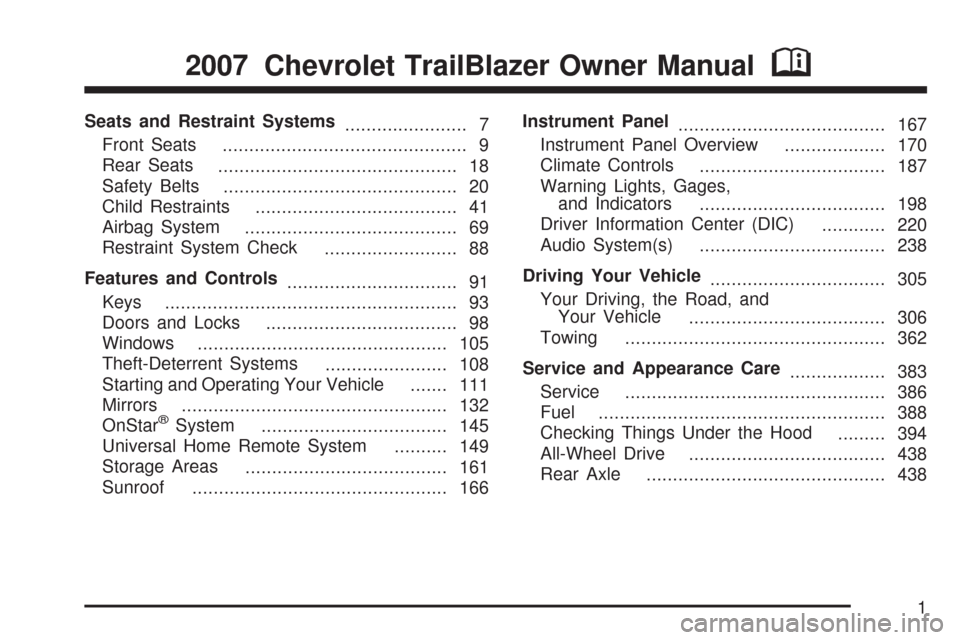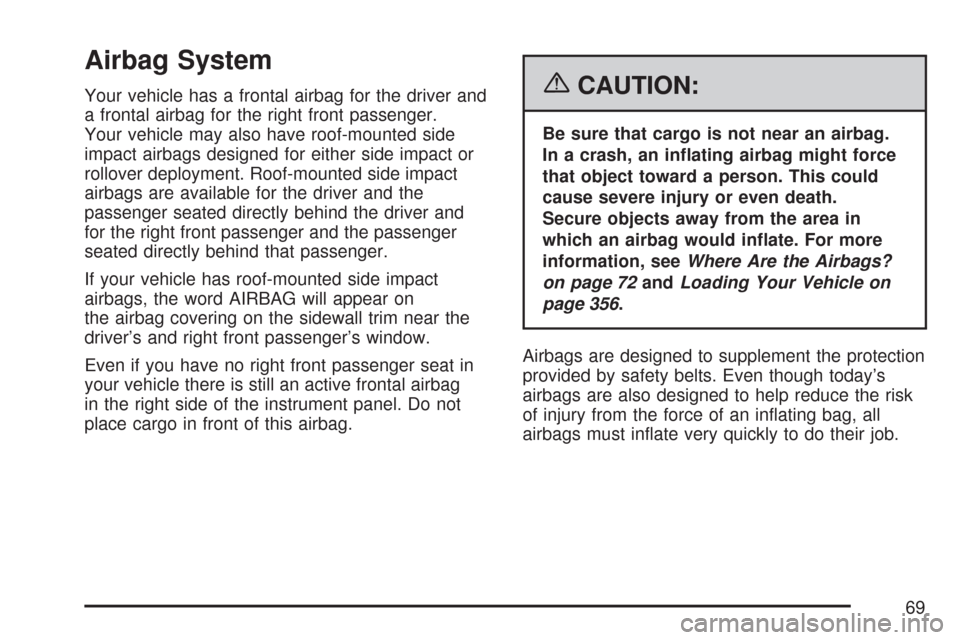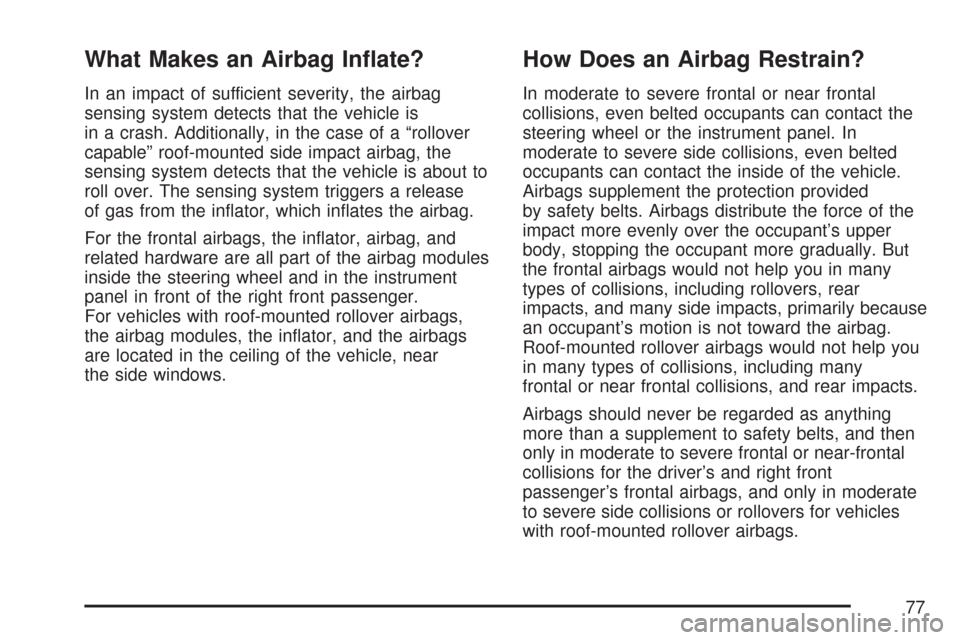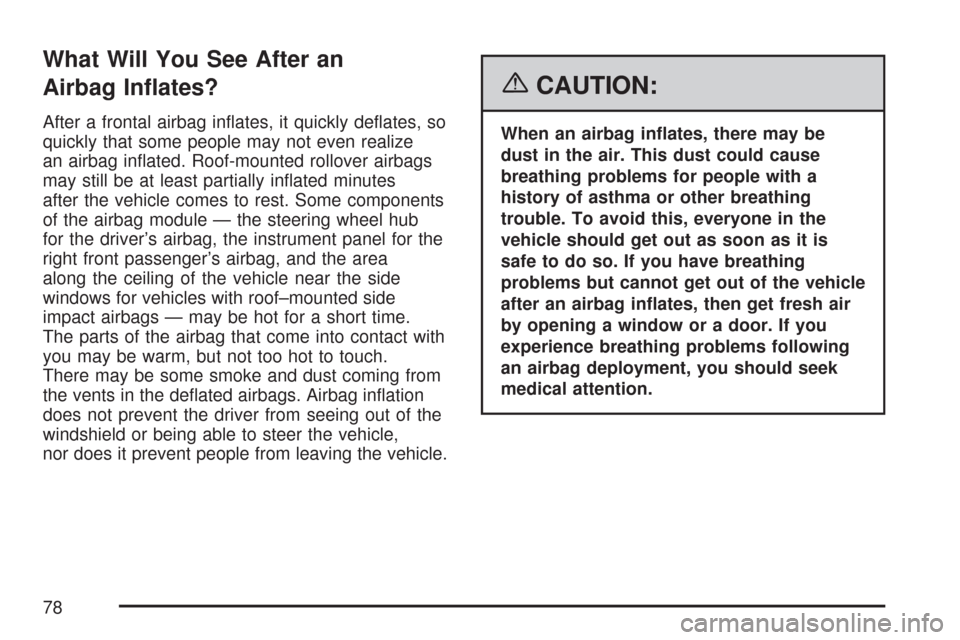Page 1 of 574

Seats and Restraint Systems
....................... 7
Front Seats
.............................................. 9
Rear Seats
............................................. 18
Safety Belts
............................................ 20
Child Restraints
...................................... 41
Airbag System
........................................ 69
Restraint System Check
......................... 88
Features and Controls
................................ 91
Keys
....................................................... 93
Doors and Locks
.................................... 98
Windows
............................................... 105
Theft-Deterrent Systems
....................... 108
Starting and Operating Your Vehicle
....... 111
Mirrors
.................................................. 132
OnStar
®System
................................... 145
Universal Home Remote System
.......... 149
Storage Areas
...................................... 161
Sunroof
................................................ 166Instrument Panel
....................................... 167
Instrument Panel Overview
................... 170
Climate Controls
................................... 187
Warning Lights, Gages,
and Indicators
................................... 198
Driver Information Center (DIC)
............ 220
Audio System(s)
................................... 238
Driving Your Vehicle
................................. 305
Your Driving, the Road, and
Your Vehicle
..................................... 306
Towing
................................................. 362
Service and Appearance Care
.................. 383
Service
................................................. 386
Fuel
...................................................... 388
Checking Things Under the Hood
......... 394
All-Wheel Drive
..................................... 438
Rear Axle
............................................. 438
2007 Chevrolet TrailBlazer Owner ManualM
1
Page 42 of 574
{CAUTION:
Never do this.
Here two children are wearing the same
belt. The belt cannot properly spread the
impact forces. In a crash, the two children
can be crushed together and seriously
injured. A belt must be used by only
one person at a time.
Q:What if a child is wearing a lap-shoulder
belt, but the child is so small that the
shoulder belt is very close to the child’s
face or neck?
A:If the child is sitting in a seat next to a
window, move the child toward the center of
the vehicle. Also seeRear Safety Belt
Comfort Guides on page 37. If the child is
sitting in the center rear seat passenger
position, move the child toward the safety belt
buckle. In either case, be sure that the
shoulder belt still is on the child’s shoulder, so
that in a crash the child’s upper body would
have the restraint that belts provide.
42
Page 49 of 574
A forward-facing child seat (C-E) provides restraint
for the child’s body with the harness and also
sometimes with surfaces such as T-shaped
or shelf-like shields.A booster seat (F-G) is a child restraint designed
to improve the �t of the vehicle’s safety belt
system. Some booster seats have a shoulder belt
positioner, and some high-back booster seats
have a �ve-point harness. A booster seat can also
help a child to see out the window.
49
Page 69 of 574

Airbag System
Your vehicle has a frontal airbag for the driver and
a frontal airbag for the right front passenger.
Your vehicle may also have roof-mounted side
impact airbags designed for either side impact or
rollover deployment. Roof-mounted side impact
airbags are available for the driver and the
passenger seated directly behind the driver and
for the right front passenger and the passenger
seated directly behind that passenger.
If your vehicle has roof-mounted side impact
airbags, the word AIRBAG will appear on
the airbag covering on the sidewall trim near the
driver’s and right front passenger’s window.
Even if you have no right front passenger seat in
your vehicle there is still an active frontal airbag
in the right side of the instrument panel. Do not
place cargo in front of this airbag.{CAUTION:
Be sure that cargo is not near an airbag.
In a crash, an in�ating airbag might force
that object toward a person. This could
cause severe injury or even death.
Secure objects away from the area in
which an airbag would in�ate. For more
information, seeWhere Are the Airbags?
on page 72andLoading Your Vehicle on
page 356.
Airbags are designed to supplement the protection
provided by safety belts. Even though today’s
airbags are also designed to help reduce the risk
of injury from the force of an in�ating bag, all
airbags must in�ate very quickly to do their job.
69
Page 73 of 574
The right front passenger’s frontal airbag is in the
instrument panel on the passenger’s side.If your vehicle has a roof-mounted airbag for the
driver and the person seated directly behind
the driver, it is located in the ceiling above the
side windows.
73
Page 74 of 574
If your vehicle has a roof-mounted airbag for the
right front passenger and the person directly
behind that passenger, it is located in the ceiling
above the side windows.
{CAUTION:
If something is between an occupant and
an airbag, the bag might not in�ate
properly or it might force the object into
that person causing severe injury or even
death. The path of an in�ating airbag must
be kept clear. Do not put anything
between an occupant and an airbag, and
do not attach or put anything on the
steering wheel hub or on or near any
other airbag covering. And, if your vehicle
has roof-mounted side impact airbags,
never secure anything to the roof of your
vehicle by routing the rope or tie down
through any door or window opening.
If you do, the path of an in�ating side
impact airbag will be blocked. The path of
an in�ating airbag must be kept clear.
74
Page 77 of 574

What Makes an Airbag In�ate?
In an impact of sufficient severity, the airbag
sensing system detects that the vehicle is
in a crash. Additionally, in the case of a “rollover
capable” roof-mounted side impact airbag, the
sensing system detects that the vehicle is about to
roll over. The sensing system triggers a release
of gas from the in�ator, which in�ates the airbag.
For the frontal airbags, the in�ator, airbag, and
related hardware are all part of the airbag modules
inside the steering wheel and in the instrument
panel in front of the right front passenger.
For vehicles with roof-mounted rollover airbags,
the airbag modules, the in�ator, and the airbags
are located in the ceiling of the vehicle, near
the side windows.
How Does an Airbag Restrain?
In moderate to severe frontal or near frontal
collisions, even belted occupants can contact the
steering wheel or the instrument panel. In
moderate to severe side collisions, even belted
occupants can contact the inside of the vehicle.
Airbags supplement the protection provided
by safety belts. Airbags distribute the force of the
impact more evenly over the occupant’s upper
body, stopping the occupant more gradually. But
the frontal airbags would not help you in many
types of collisions, including rollovers, rear
impacts, and many side impacts, primarily because
an occupant’s motion is not toward the airbag.
Roof-mounted rollover airbags would not help you
in many types of collisions, including many
frontal or near frontal collisions, and rear impacts.
Airbags should never be regarded as anything
more than a supplement to safety belts, and then
only in moderate to severe frontal or near-frontal
collisions for the driver’s and right front
passenger’s frontal airbags, and only in moderate
to severe side collisions or rollovers for vehicles
with roof-mounted rollover airbags.
77
Page 78 of 574

What Will You See After an
Airbag In�ates?
After a frontal airbag in�ates, it quickly de�ates, so
quickly that some people may not even realize
an airbag in�ated. Roof-mounted rollover airbags
may still be at least partially in�ated minutes
after the vehicle comes to rest. Some components
of the airbag module — the steering wheel hub
for the driver’s airbag, the instrument panel for the
right front passenger’s airbag, and the area
along the ceiling of the vehicle near the side
windows for vehicles with roof–mounted side
impact airbags — may be hot for a short time.
The parts of the airbag that come into contact with
you may be warm, but not too hot to touch.
There may be some smoke and dust coming from
the vents in the de�ated airbags. Airbag in�ation
does not prevent the driver from seeing out of the
windshield or being able to steer the vehicle,
nor does it prevent people from leaving the vehicle.
{CAUTION:
When an airbag in�ates, there may be
dust in the air. This dust could cause
breathing problems for people with a
history of asthma or other breathing
trouble. To avoid this, everyone in the
vehicle should get out as soon as it is
safe to do so. If you have breathing
problems but cannot get out of the vehicle
after an airbag in�ates, then get fresh air
by opening a window or a door. If you
experience breathing problems following
an airbag deployment, you should seek
medical attention.
78